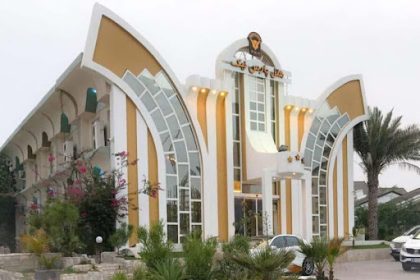Zaman Museum of Tehran is one of the spectacular historical and cultural places in Tehran that must be visited at least once. This museum, which is located in the beautiful Kushk Ahmadshahi mansion, displays a unique collection of old clocks and objects related to timekeeping. This museum is not only an exhibition of clocks and time measuring tools, but also opens a window to the historical past of Tehran and the architectural style of that era.
Of course, many tourists may think that they are dealing with a boring and scientific museum; But the Tehran Clock Museum is a complete collection of historical, scientific, artistic and architectural beauties. Also, the magnificent mansion and its green space are suitable for photography. In the rest of this article from tourism magazine fly todayWe get to know this museum and its different parts.
Where is the Museum of Time?
If you walk in the back alleys of Zafaranieh Street in Tehran, a mansion with a turquoise facade and different facade decorations will attract your attention and you will probably be curious to know its exact use. This beautiful and turquoise building is the Museum of Time or Clock Museum, which is named Museum of the audience of time It is also mentioned and is considered one of the most important museums in Tehran.
In this museum, you can have a different and deeper look at the clock and the topic of time and look at it from different angles. Of course, the clock is not the only reason for the attraction of this museum; The eye-catching and artistic architecture of its building is another reason for the popularity and importance of Tamasheh Zaman Museum.
- address: Tehran, Valiasr St., Shahid Falahi St. (Zafraniyeh), No. 6, corner of Parzin Baghdadi Crossroads.
- phone: 02122417336
How to go to the Museum of Time?
To access the Museum of Time, you can use a private car, subway or BRT bus. In the following, we will examine each of these methods together.
Access to the Museum of Time by private car
If you plan to go to Zaman Museum by car, go to Zafaranieh from Valiasr Street and before Tajrish Square. At the corner of Parzin Baghdadi intersection, you can see the museum of time. If you look around the nearby streets, you will definitely find a parking space nearby.
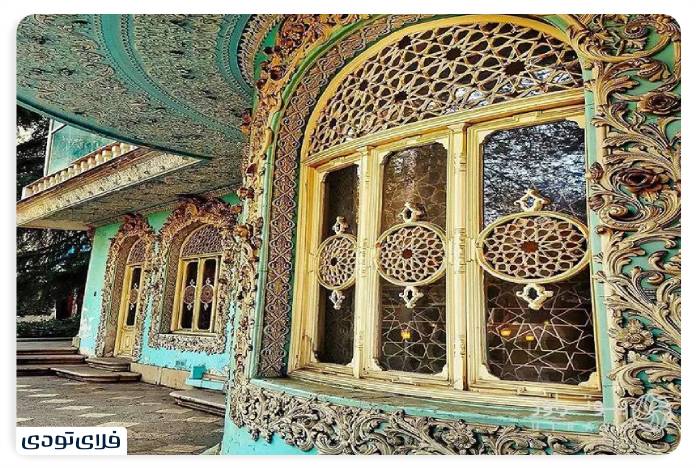
Access to Tehran Museum of Time by metro
use of Tehran Metrois another way to go back in time. The closest metro station to Zaman Museum is Tajrish station; Therefore, to go to this museum, you have to get off the metro at Tajrish station and walk along Valiasr Street until you reach Zafaranieh Street. It takes about 20 minutes to walk this route; Of course, you can also take Tajrish line taxis to Serah Asif and get off at Zafaranieh Street.
Access to the Museum of Time by bus
If you ride BRT line 7 buses, on the railway route to Tajrish, you can get off the bus at Valiasr street and at Bagh Ferdous station. It is not a long way from Ferdous Garden to the Museum of Time and it is enough to go down Valiasr Street and enter Zafaranieh.
What are the working hours and ticket price of Tehran Museum of Time?
It is possible to visit the Tehran Clock Museum and its treasures every day from 8:00 AM to 8:00 PM. The price of the entrance ticket to the museum is 43 thousand tomans, which you have to pay at the beginning of entering the museum. Of course, if you only want to visit the open area and the courtyard of the museum, you can pay only 20,000 Tomans for the ticket. Of course, note that in this case, you will not be able to visit the museum of time and the treasure of watches in the collection.
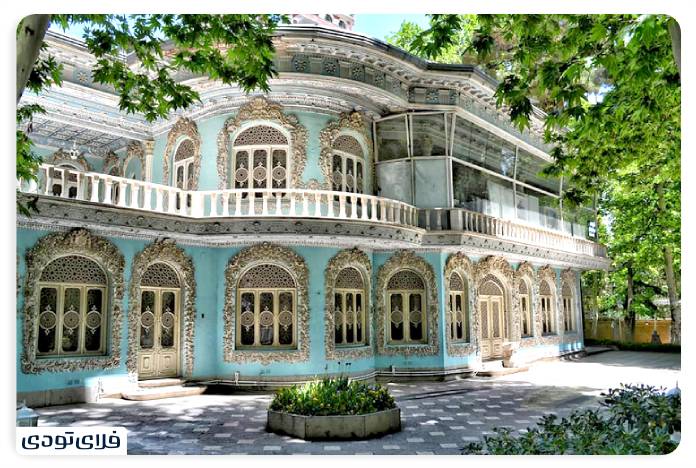
Learn more about the history of the Museum of Time
If we want to know more about the background of the original building of the Zaman Museum in Tehran, we must go back to the Qajar era and the time of Naser al-Din Shah’s rule. This garden, with an area of 5000 square meters, was a part of Ferdows Garden and Naseruddin Shah gave it to his daughter and son-in-law Muir al-Mamalek as part of a wedding gift. In the middle of this garden, there was a clay and mud mansion that was not similar to the current mansion. This garden was in the hands of the heirs of Muir Al Mamalek and later Abdullah Khan Mansour until 1346, until a person named Hossein Khodadad, one of the famous carpet traders, bought this property.
The flourishing period of the building of the mansion began exactly from this time. By order of Hossein Khodadad, a group of prominent architects, plasterers and artists came together to restore the building of this garden, and over a period of several years, they created a structure with an iron frame and artistic Iranian architecture. The reconstruction of the building was finished in 1356 and it was used as the residence of Hossein Khodadad’s family for about a year.
After the revolution, the garden and the mansion were confiscated by the Mustafafan Foundation and its doors were closed to the public for many years. Until 1378, this museum started its work under the name Tamashaghe Zaman Museum, and its doors were open to those interested, and the museum was registered in the list of national monuments in 1382.
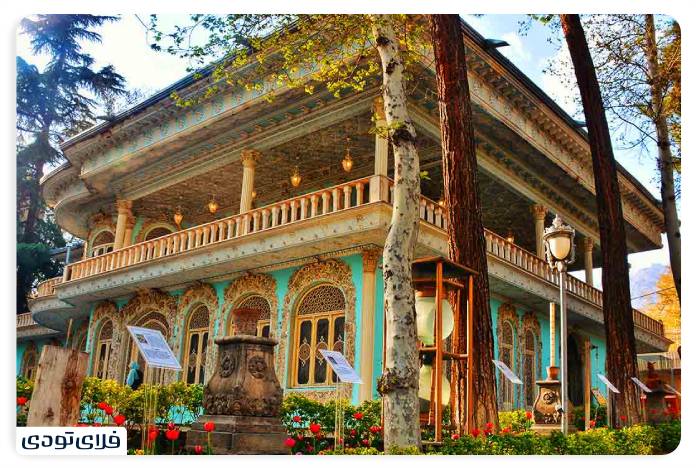
Getting to know the stunning architecture of Tehran’s Zaman Museum garden
Zaman Museum Garden is located on a land of 5000 square meters and its building area is 700 square meters. If you go to this museum for the first time, the turquoise blue color and artistic plastering in its structure will attract your attention more than anything else. The cooperation of a large number of the most experienced artists in the architecture and construction of this building has resulted in the creation of an eye-catching collection, and this has made the Museum of Time one of the representative works of integrated architecture in Tehran.
The colorful windows, moqrans works, brick works, plastering and mirror works of the Museum of Time, all speak of the mastery, art and taste of its creator; So that Iranian and foreign art are combined in the best and most beautiful way in its construction. In describing the beauty of the plasterwork of this building, it is enough that the decoration of one of the rooms on the upper floor, known as the Isfahani room, lasted for about 3 years. In addition to plastering, miniature paintings and stunning knotwork can also be seen in places of the Museum of Time. The sum of all these beauties has given this building a very special and spectacular view.
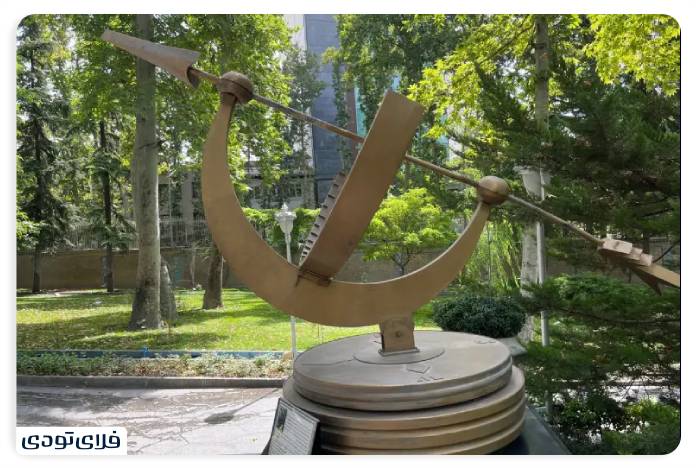
What do we see in the museum of time?
The Museum of Time is the first museum in Iran that was opened with the center of the clock and all the objects in the museum are somehow related to the clock or time. From the watches of famous people such as Dr. Hasabi and Naseruddin Shah to the tools and how to repair watches, you can see them in the attractive environment of this museum.
Seeing the prototypes of time display tools in the past centuries alongside the most modern and complicated clocks invented by mankind is a fascinating and unique experience that a visit to this museum will bring you. In addition, by walking through the various sections of the Museum of Time, you can get complete information about the technology of making clocks and types of calendars and clocks, and visit a large number of antique clocks from different countries of the world.
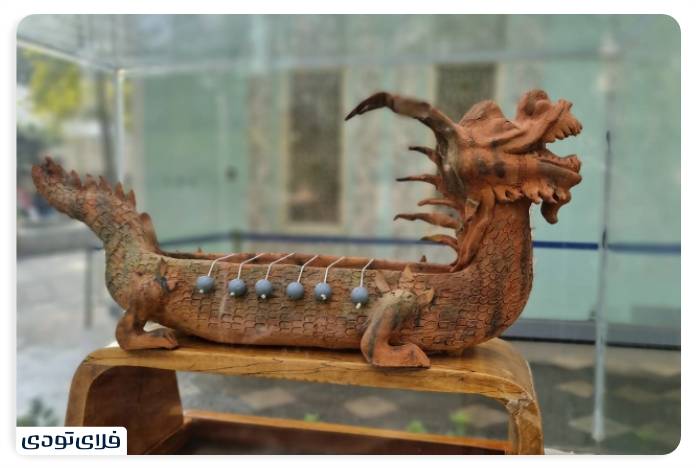
Get to know the different parts of Tehran Museum of Time
Among the different sections of the Museum of Time, the sights are divided in a classified manner and invite tourists to see the works and beautiful architecture. It’s not bad to go around these parts together and review the sights of each part.
The grounds of the Museum of Time A beautiful landscape with tall trees
The area and garden of the Museum of Time is the first part that you encounter when entering the museum. This part, which was actually a part of Ferdous Garden, has strong and green trees, a 30-meter deep pool and two stone lion heads next to the pool. In this part of the museum, you can see the old timepieces closely and get to know how they work.
- sundial which is one of the oldest tools for displaying time and dates back to about 5000 years ago, it is considered one of the interesting objects in the museum garden. In addition, you can see different types of ancient clocks in this section and by reading the information and how each of these clocks work, you can get useful information about the path of human civilization. In the following, we will get to know the most prominent ancient clocks in the courtyard of the Museum of Time.
- blue hour: One of the oldest ways to know the time is to use a blue clock, one of the examples of this clock is in the Museum of Time. A water clock is actually a graduated container with a hole that was filled with water and after a few hours, they estimated the time by seeing the amount of water left in the container.
- candle clock: The candle clock is actually a graduated candle that was lit and after it melted, they would know the time from the remaining degree on the body of the candle. There is an example of this clock in the clock museum area for visiting and you can see its working method up close.
- hourglass: You are probably familiar with the function and image of the hourglass and you know that this hourglass consists of two tanks filled with sand. The amount of sand discharged from the upper tank to the lower tank can show the time in an approximate way. You can see the magnificent hourglass of the Museum of Time in a corner of the courtyard of this museum and get to know its operation closely.
- sundial: The sundial is one of the oldest examples of ancient clocks, whose history reaches about 5500 years ago. This watch works by the sun shining and forming a shadow on the indicator and is one of the most popular types of watches over the centuries.
- oil clock: The working method of an oil clock is very similar to a blue clock. In this clock, instead of water, oil was poured into a measuring container and by lighting the wick under the container and burning the oil, they measured the time from some remaining oil.
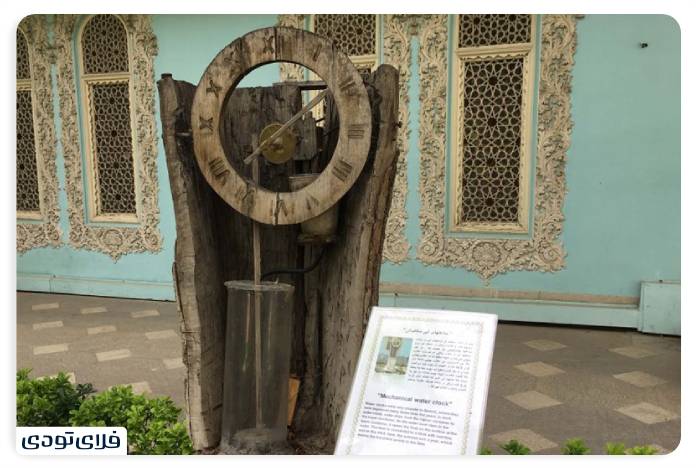
The first floor of Tehran Museum of Time Visiting ancient and expensive watches
The first floor of the Tehran Clock Museum is dedicated to clocks belonging to the 17th to 20th centuries. In this section, you can see expensive watches designed and made by artists around the world or by the world’s largest watchmaking companies with many decorations. If you are interested in watches and their brands, you can see watches from famous brands such as Tiffany, Balthazar and Pelbor on this floor. The Hall of Fame is also located on this floor of the museum, and watches that famous Iranian people have received as gifts during their foreign trips are on display.
As we said before, the clock museum is only part of the charm of this mansion, and while visiting this museum, you should not neglect to look at its walls and architecture. For example, the room of the Isfahanis is considered one of the most important parts of this floor of the museum, although its importance is unrelated to the issue of the clock and its unique architecture.
This room is located on the west side of the building and the reason for its name is the presence of Iranian and traditional decorations in the architecture of the room. It is said that the decoration of Isfahani’s room was inspired by the magnificent mansion and famous landmarks of the Safavid era. As we said before, it took 3 years to complete this room alone, and gold and copper were used in its decoration and plastering.
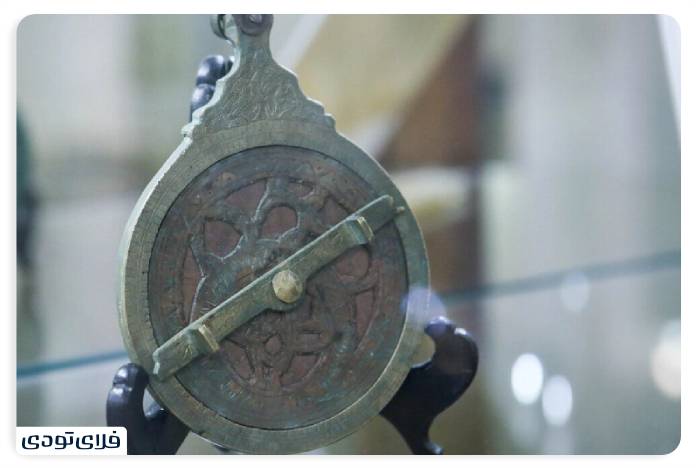
The second floor of Tehran Museum of Time Getting to know the history and how to make watches
The second floor of the Museum of Time, just like a fascinating scientific trip, takes you to the land of clocks and provides you with complete information on the history of clocks in the world, how to make them, and tools for repairing clocks in detail. Of course, the clock is not the only topic that is discussed in this part of the museum. In parts of the second floor, you can see historical instruments of astronomy and ancient astrolabes in the museum’s calendrical section.
In another part of this floor, you can see watches donated by many famous people. The watches of people like Muzaffaruddin Shah and Naseruddin Shah, as well as famous figures like Dr. Hasabi and Mohammad Ali Keshavarz are kept in this part of the museum. A part of the second floor has been dedicated to art exhibitions and a number of Houshang Frouten’s artworks centered on the clock have been displayed.
What are the restaurants near Tehran’s Museum of Time?
You may feel hungry after spending fascinating hours in different sections of the Museum of Time and look for a restaurant with a suitable menu and atmosphere. This need has been well seen in the Museum of Time and a pleasant space has been assigned to the cafe. At Zaman Museum Cafe, you can sit with your loved ones for an hour, enjoy the green and beautiful atmosphere of the garden and choose your favorite food from the varied menu of the cafe. If you want to visit other restaurants around here, you have some other suitable options, some of which we will mention below:
- white fish restaurant;
- Shmron Kebab;
- Naib Zafaranieh restaurant.
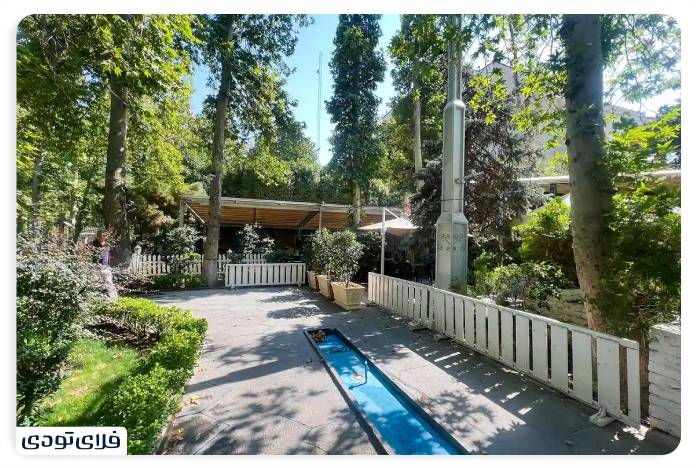
What are the hotels near the Museum of Time?
If you have traveled to Tehran and want to see the Museum of Time and the tourist attractions of the region, you are probably looking for room reservations in hotels in the same area. Therefore, we will introduce a number of hotels in Tehran, where you will have good access to the Museum of Time by staying in them:
- Asa Apartment Hotel;
- Lotus Hotel;
- Oak Hotel
What are the places of interest near the Museum of Time?
If you explore the capital a little, you will realize that Sightseeing places in Tehran are numerous and diverse. In the area of Valiasr Street in Tehran and around Zaman Museum, it is full of sights that every tourist enjoys visiting. Our suggestion is that if you visit the Museum of Time, don’t miss seeing Valiasr street and its beautiful trees and tourist attractions around it. In the following, we will name a number of prominent sights around the Museum of Time, so that if you wish, after visiting the museum, you can visit them as well:
- Saadabad Palace;
- Tajrish market;
- Imamzadeh Saleh;
- Ferdows Museum Garden.
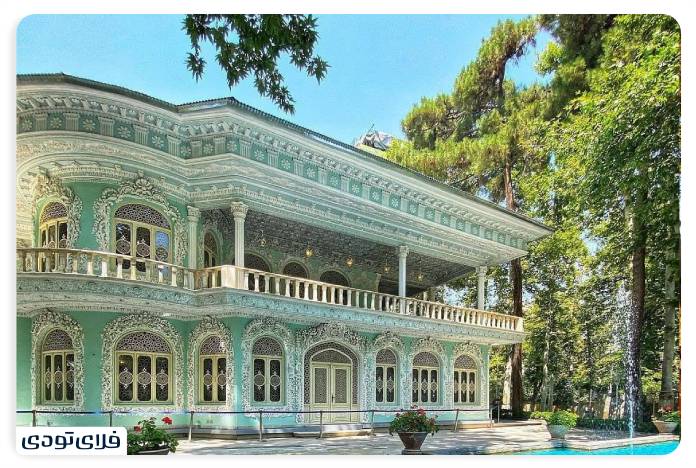
A trip to the land of hours in the watch of time
Perhaps it is safe to say that Tehran’s Museum of Time is one of the most different and at the same time the most complete museums in Tehran. A museum whose building has seen strange and different events over the years and is considered one of the brilliant manifestations of Iranian architecture. At the same time, it has covered one of the most attractive topics among museums, focusing on time and clocks. Visiting the Museum of Time Spectators and spending hours among its hands and plasterwork will bring you moments full of pleasure.
In this section, we tried to approach this museum from different angles and examine the architecture and different parts of this attraction separately. Our suggestion is that if you happen to pass by Valiasr Street, besides enjoying walking in the street, you should also visit the Museum of Time. If you have any questions or comments about Clock Museum, we would love to read your comments in the comments section. If you have visited this museum before, write us which part was the most interesting in your opinion? for what reason
Frequently asked questions About Tehran Museum of Time
Where is Tehran’s Museum of Time located?
Zaman Museum or Tehran Clock Museum is located in Zafaranieh Street, Tehran, at the corner of Parzin Baghdadi intersection.
When can you visit Tehran’s Museum of Time?
The doors of the museum are open to visitors every day from 8 am to 8 pm and it is possible to visit the museum during these hours.
Is it free to visit Tehran Museum of Time?
No, the entrance fee of the Museum of Time is 43 thousand tomans. Of course, if you only want to visit the yard and open area of the garden, you have to pay 20 thousand tomans.
Can you go to the Museum of Time by subway?
Yes, get off the metro at Tajrish station. After spending about 20 minutes, walk along Valiasr Street and then Zafaranieh to reach the Clock Museum.
Are there any other tourist attractions near the Museum of Time?
Yes, Ferdows Garden, Saadabad Palace and Tajrish Bazaar are among the places of interest that are located near the Clock Museum.
RCO NEWS















